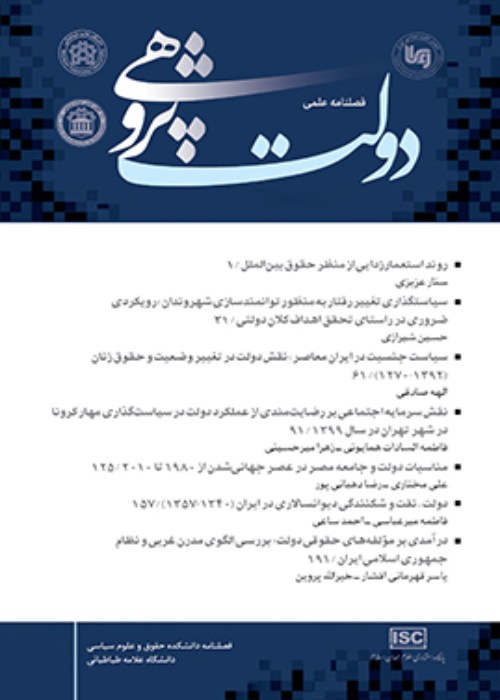Comparative Look at the Metaphysical Foundations of State Theory in Ancient Iran and China
Author(s):
Abstract:
Brushing aside the development of conceptual elements of Iranian and Chinese cosmologies, as yet we can generally specify their certain identity as a system. The main question is that what kind of relation has there been between political theory and metaphysical foundations in ancient Iran and China and how can we conceptualize this relation? Chinese Cosmology: In Chinese cosmology, the universe is the kingdom of dynamics, vital force and spiritual theme and its values incline toward the good. The good has its origin in God, being or nature. However, there needs human attempt for its achievement. In one of the first ideas of Chinese cosmology, the universe consists of nine elements. The eighth element includes various signs which elaborate on King’s duties and guides him. The untimely emergence of signs is an alert to king so that he change his behavior. Harmony and balance are the main aspects of Chinese cosmology. This principle implies that all forms of individual life should be considered valuable. The complete fulfillment of our being and of other beings is possible in regard with fairness, justice and unselfishness. This principle implies total equality of all forms of individual life and maintaining its life and dignity in all forms. This means that all of them are entitled to be treated with kindness. Iranian Cosmology: There is some form of cosmic circle in Iranian cosmology which involves the conflict of good and evil. This conflict ultimately leads to the conquest of good over evil. In fact, the higher stage of human perfection and is accomplished in Resurrection. The cosmic circle in Iranian cosmology leads to Resurrection and perennial annihilation of evildoers, and the rule of Ashe and the ultimate kingship of Ahura Mazda. In this cosmology, The King is considered the chosen of heavenly gods. The king considered himself as director of gods’ affairs. Therefore, the kings can attempt to set up justice. Also, in Iranian beliefs, there is an interesting parallel between social degrees and cosmological hierarchies. Mitra and Verone were the symbol of religious caste, Indere the symbol of warriors caste, and Nasite the symbol of producers caste. Of course, in old Chinese myths, the system of social configuration had a divine dimension too. In one of old Chinese myths, humans which is composed of yellow clay turn into nobles, and humans which is composed of dust turn into the people.
Conclusion
The Iranian dualistic thought involves the conception of the promised man and political leader as a authority which is connected with Resurrection. But, Chinese thought is monistic the evil forces don’t have a fundamental status in it. In Chinese wisdom, political leadership belongs to the learned the learned leader doesn’t have an status in Resurrection and final deliverance.Keywords:
Language:
Persian
Published:
Studies the State, Volume:1 Issue: 1, 2015
Page:
1
magiran.com/p1482320
دانلود و مطالعه متن این مقاله با یکی از روشهای زیر امکان پذیر است:
اشتراک شخصی
با عضویت و پرداخت آنلاین حق اشتراک یکساله به مبلغ 1,390,000ريال میتوانید 70 عنوان مطلب دانلود کنید!
اشتراک سازمانی
به کتابخانه دانشگاه یا محل کار خود پیشنهاد کنید تا اشتراک سازمانی این پایگاه را برای دسترسی نامحدود همه کاربران به متن مطالب تهیه نمایند!
توجه!
- حق عضویت دریافتی صرف حمایت از نشریات عضو و نگهداری، تکمیل و توسعه مگیران میشود.
- پرداخت حق اشتراک و دانلود مقالات اجازه بازنشر آن در سایر رسانههای چاپی و دیجیتال را به کاربر نمیدهد.
In order to view content subscription is required
Personal subscription
Subscribe magiran.com for 70 € euros via PayPal and download 70 articles during a year.
Organization subscription
Please contact us to subscribe your university or library for unlimited access!


